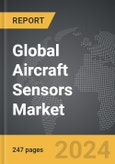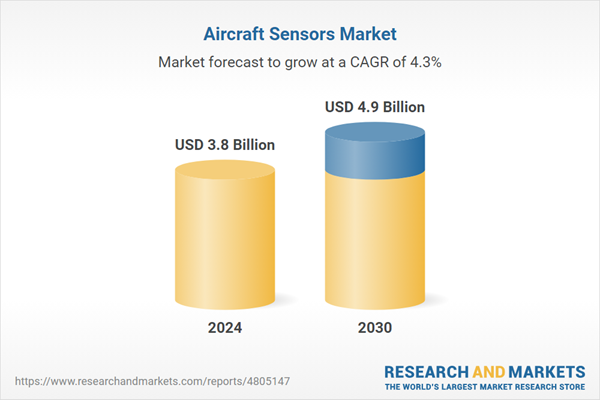The global market for Aircraft Sensors was valued at US$3.8 Billion in 2024 and is projected to reach US$4.9 Billion by 2030, growing at a CAGR of 4.3% from 2024 to 2030. This comprehensive report provides an in-depth analysis of market trends, drivers, and forecasts, helping you make informed business decisions. The report includes the most recent global tariff developments and how they impact the Aircraft Sensors market.
Segments: Platform (Fixed Wing Aircraft, Rotary Wing Aircraft, UAVs); Sensor Type (Altimeter Sensors, Pressure Sensors, GPS Sensors, Gyroscopes, Other Sensor Types); Connectivity (Wired, Wireless).
Geographic Regions/Countries: World; United States; Canada; Japan; China; Europe (France; Germany; Italy; United Kingdom; Spain; Russia; and Rest of Europe); Asia-Pacific (Australia; India; South Korea; and Rest of Asia-Pacific); Latin America (Argentina; Brazil; Mexico; and Rest of Latin America); Middle East (Iran; Israel; Saudi Arabia; United Arab Emirates; and Rest of Middle East); and Africa.
The analysts continuously track trade developments worldwide, drawing insights from leading global economists and over 200 industry and policy institutions, including think tanks, trade organizations, and national economic advisory bodies. This intelligence is integrated into forecasting models to provide timely, data-driven analysis of emerging risks and opportunities.
Global Aircraft Sensors Market - Key Trends and Drivers Summarized
How Do Aircraft Sensors Ensure Safety and Efficiency in Aviation?
Aircraft sensors are indispensable components in modern aviation, playing a critical role in ensuring both safety and operational efficiency. These sensors are integrated into various systems of the aircraft, providing real-time data on numerous parameters such as altitude, speed, pressure, temperature, and structural integrity. By continuously monitoring these factors, sensors enable pilots and onboard systems to make informed decisions, thereby enhancing flight safety. Additionally, sensors are pivotal in predictive maintenance, alerting ground crews to potential issues before they become critical, thus reducing downtime and maintenance costs. The data collected by these sensors are also vital for air traffic management, helping to streamline flight operations and reduce congestion in increasingly busy airspace.What Technological Innovations Are Shaping the Future of Aircraft Sensors?
The future of aircraft sensors is being shaped by rapid technological advancements that are pushing the boundaries of what these devices can do. One significant innovation is the development of wireless sensor networks, which offer the advantage of reduced weight and complexity compared to traditional wired systems. Another groundbreaking technology is the integration of micro-electromechanical systems (MEMS), which are compact, reliable, and capable of measuring a wide range of parameters with high precision. Advances in materials science are also leading to the creation of sensors that can withstand extreme environmental conditions, ensuring accurate performance even in the harshest climates. Furthermore, the incorporation of artificial intelligence (AI) and machine learning algorithms is enabling sensors to not only collect data but also analyze it in real-time, providing actionable insights for improved decision-making.How Are Market Trends Influencing the Adoption of Aircraft Sensors?
The adoption of aircraft sensors is being driven by several key market trends that reflect evolving industry needs and consumer expectations. One major trend is the increasing focus on fuel efficiency and emissions reduction. Sensors that monitor engine performance, fuel consumption, and aerodynamic conditions are crucial for optimizing flight operations and minimizing environmental impact. The rise of electric and hybrid-electric aircraft is also generating demand for specialized sensors that can handle the unique requirements of these propulsion systems. Additionally, the growing emphasis on passenger comfort and safety is leading to the integration of advanced sensors in cabin systems, monitoring air quality, temperature, and noise levels. The expansion of the Internet of Things (IoT) within the aviation sector is another significant trend, as it enables enhanced connectivity and data sharing between aircraft and ground systems, fostering more efficient and responsive operations.What Factors Are Driving Growth in the Aircraft Sensors Market?
The growth in the aircraft sensors market is driven by several factors. Technological advancements, such as the development of MEMS and wireless sensor networks, are propelling the adoption of more sophisticated and efficient sensor systems. The increasing complexity of modern aircraft, including the advent of electric and hybrid-electric propulsion systems, is creating a demand for new types of sensors that can address specific operational needs. Regulatory requirements for enhanced safety and environmental performance are also significant drivers, as they necessitate the incorporation of advanced sensors to comply with stringent standards. Furthermore, the rising focus on predictive maintenance and the need to reduce operational costs are encouraging airlines to invest in sensor technologies that can provide real-time monitoring and diagnostics. Consumer expectations for improved flight experience, including better cabin conditions and in-flight connectivity, are driving the integration of advanced sensors in passenger areas. Lastly, the expansion of global air traffic and the subsequent need for more efficient air traffic management are contributing to the increased demand for aircraft sensors that facilitate real-time data sharing and operational optimization.Report Scope
The report analyzes the Aircraft Sensors market, presented in terms of units. The analysis covers the key segments and geographic regions outlined below.Segments: Platform (Fixed Wing Aircraft, Rotary Wing Aircraft, UAVs); Sensor Type (Altimeter Sensors, Pressure Sensors, GPS Sensors, Gyroscopes, Other Sensor Types); Connectivity (Wired, Wireless).
Geographic Regions/Countries: World; United States; Canada; Japan; China; Europe (France; Germany; Italy; United Kingdom; Spain; Russia; and Rest of Europe); Asia-Pacific (Australia; India; South Korea; and Rest of Asia-Pacific); Latin America (Argentina; Brazil; Mexico; and Rest of Latin America); Middle East (Iran; Israel; Saudi Arabia; United Arab Emirates; and Rest of Middle East); and Africa.
Key Insights:
- Market Growth: Understand the significant growth trajectory of the Fixed Wing Aircraft Sensors segment, which is expected to reach US$3.9 Billion by 2030 with a CAGR of a 4.2%. The Rotary Wing Aircraft Sensors segment is also set to grow at 4.3% CAGR over the analysis period.
- Regional Analysis: Gain insights into the U.S. market, valued at $1.0 Billion in 2024, and China, forecasted to grow at an impressive 7.1% CAGR to reach $1.0 Billion by 2030. Discover growth trends in other key regions, including Japan, Canada, Germany, and the Asia-Pacific.
Why You Should Buy This Report:
- Detailed Market Analysis: Access a thorough analysis of the Global Aircraft Sensors Market, covering all major geographic regions and market segments.
- Competitive Insights: Get an overview of the competitive landscape, including the market presence of major players across different geographies.
- Future Trends and Drivers: Understand the key trends and drivers shaping the future of the Global Aircraft Sensors Market.
- Actionable Insights: Benefit from actionable insights that can help you identify new revenue opportunities and make strategic business decisions.
Key Questions Answered:
- How is the Global Aircraft Sensors Market expected to evolve by 2030?
- What are the main drivers and restraints affecting the market?
- Which market segments will grow the most over the forecast period?
- How will market shares for different regions and segments change by 2030?
- Who are the leading players in the market, and what are their prospects?
Report Features:
- Comprehensive Market Data: Independent analysis of annual sales and market forecasts in US$ Million from 2024 to 2030.
- In-Depth Regional Analysis: Detailed insights into key markets, including the U.S., China, Japan, Canada, Europe, Asia-Pacific, Latin America, Middle East, and Africa.
- Company Profiles: Coverage of players such as AMETEK, Inc., Curtiss-Wright Corporation, Esterline Technologies Corporation, General Electric Company, Honeywell International, Inc. and more.
- Complimentary Updates: Receive free report updates for one year to keep you informed of the latest market developments.
Some of the 47 companies featured in this Aircraft Sensors market report include:
- AMETEK, Inc.
- Curtiss-Wright Corporation
- Esterline Technologies Corporation
- General Electric Company
- Honeywell International, Inc.
- Meggitt PLC
- Raytheon Company
- Safran Electronics & Defense
- TE Connectivity Ltd.
- Thales Group
Tariff Impact Analysis: Key Insights for 2025
Global tariff negotiations across 180+ countries are reshaping supply chains, costs, and competitiveness. This report reflects the latest developments as of April 2025 and incorporates forward-looking insights into the market outlook.The analysts continuously track trade developments worldwide, drawing insights from leading global economists and over 200 industry and policy institutions, including think tanks, trade organizations, and national economic advisory bodies. This intelligence is integrated into forecasting models to provide timely, data-driven analysis of emerging risks and opportunities.
What’s Included in This Edition:
- Tariff-adjusted market forecasts by region and segment
- Analysis of cost and supply chain implications by sourcing and trade exposure
- Strategic insights into geographic shifts
Buyers receive a free July 2025 update with:
- Finalized tariff impacts and new trade agreement effects
- Updated projections reflecting global sourcing and cost shifts
- Expanded country-specific coverage across the industry
Table of Contents
I. METHODOLOGYII. EXECUTIVE SUMMARY2. FOCUS ON SELECT PLAYERSIII. MARKET ANALYSISCANADAITALYSPAINRUSSIAREST OF EUROPESOUTH KOREAREST OF ASIA-PACIFICARGENTINABRAZILMEXICOREST OF LATIN AMERICAIRANISRAELSAUDI ARABIAUNITED ARAB EMIRATESREST OF MIDDLE EASTIV. COMPETITION
1. MARKET OVERVIEW
3. MARKET TRENDS & DRIVERS
4. GLOBAL MARKET PERSPECTIVE
UNITED STATES
JAPAN
CHINA
EUROPE
FRANCE
GERMANY
UNITED KINGDOM
ASIA-PACIFIC
AUSTRALIA
INDIA
LATIN AMERICA
MIDDLE EAST
AFRICA
Companies Mentioned (Partial List)
A selection of companies mentioned in this report includes, but is not limited to:
- AMETEK, Inc.
- Curtiss-Wright Corporation
- Esterline Technologies Corporation
- General Electric Company
- Honeywell International, Inc.
- Meggitt PLC
- Raytheon Company
- Safran Electronics & Defense
- TE Connectivity Ltd.
- Thales Group
Table Information
| Report Attribute | Details |
|---|---|
| No. of Pages | 247 |
| Published | April 2025 |
| Forecast Period | 2024 - 2030 |
| Estimated Market Value ( USD | $ 3.8 Billion |
| Forecasted Market Value ( USD | $ 4.9 Billion |
| Compound Annual Growth Rate | 4.3% |
| Regions Covered | Global |









